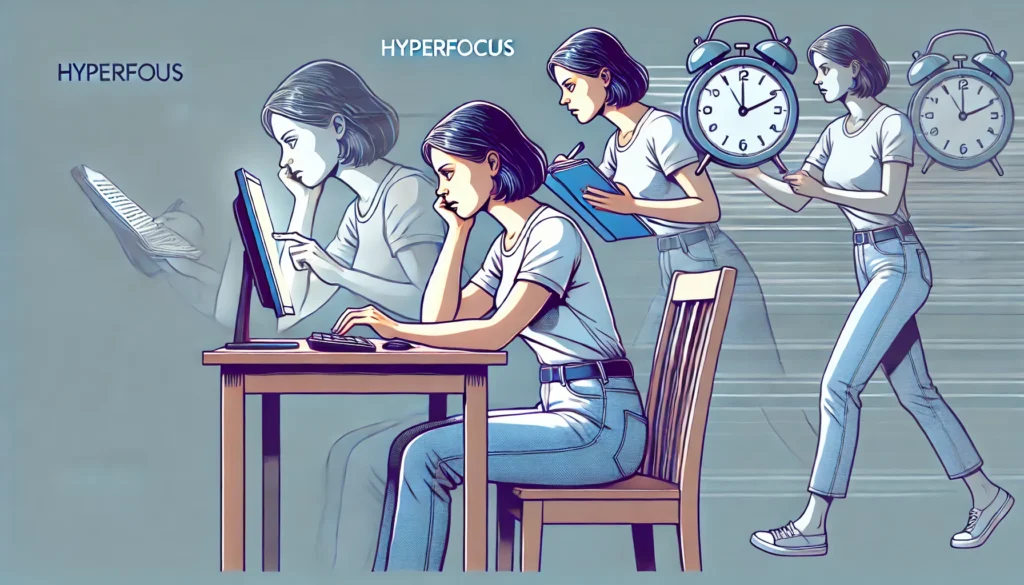ADHD in women often manifests differently than in men, which can lead to significant gaps in diagnosis and treatment. While hyperactivity is a hallmark sign in males, females are more likely to exhibit inattentive symptoms. These symptoms can include difficulty concentrating, disorganization, forgetfulness, and a tendency to daydream. Unfortunately, these signs of ADHD in women can easily be mistaken for character flaws or mood disorders, complicating accurate diagnosis and treatment.
You may also like: Enhancing Concentration: Strategies for ADHD
The Inattentive Presentation
Inattentive symptoms in women often fly under the radar. Women with ADHD may struggle to focus on tasks, particularly those that are mundane or repetitive, leading to challenges in both personal and professional settings. They might also face chronic disorganization, resulting in missed deadlines and misplaced items. Forgetfulness is another common symptom, with women regularly forgetting appointments, commitments, or even daily tasks.
Misinterpretation of Symptoms
These inattentive symptoms can often be misinterpreted as laziness or lack of interest, rather than being recognized as part of a neurodevelopmental disorder. This misinterpretation can lead to feelings of inadequacy and self-doubt. Emotional dysregulation, characterized by intense emotional responses that may feel overwhelming or inappropriate to the situation, is another symptom that is often misunderstood.
Overlapping Conditions
The manifestation of ADHD in women is further complicated by the presence of overlapping conditions. Many women with ADHD also experience anxiety, depression, or other mood disorders, which can obscure the root cause of their challenges. This overlap can lead to a misdiagnosis, where the focus is placed on treating the more visible symptoms of anxiety or depression rather than addressing the underlying ADHD.
Adult Female ADHD Symptoms
Adult women with ADHD frequently experience a range of symptoms that impact their daily lives. These symptoms can vary widely in intensity and presentation, but some of the most common include inattentiveness, disorganization, forgetfulness, emotional dysregulation, impulsivity, and hyperfocus.
Inattentiveness and Disorganization
Inattentiveness and disorganization are often interlinked in women with ADHD. The inability to focus can lead to a chaotic environment, where tasks are left unfinished, and important items are frequently misplaced. This disarray can extend to professional environments, where meeting deadlines and maintaining productivity become significant challenges.
Emotional Dysregulation and Impulsivity
Women with ADHD often experience emotional dysregulation, which can manifest as intense emotional responses that seem disproportionate to the situation. This can lead to impulsivity, where decisions are made without fully considering the consequences, often resulting in regret. Managing these emotional and behavioral responses is a crucial aspect of managing ADHD in women.
Hyperfocus and Its Detriments
Hyperfocus, while seemingly productive, can actually be detrimental. Women with ADHD might become intensely absorbed in certain activities to the exclusion of others, neglecting other responsibilities or self-care in the process. This can lead to a cycle of burnout, where periods of intense productivity are followed by exhaustion and decreased functioning.

Diagnosing ADHD in Adult Women
Diagnosing ADHD in adult women presents unique challenges. The traditional diagnostic criteria were developed based on research involving young boys, which means that many women do not recognize their symptoms as indicative of ADHD. Additionally, societal expectations and gender roles can further obscure the signs of ADHD in females, leading women to internalize their struggles and attribute them to personal failings.
Historical Diagnostic Bias
The historical bias in ADHD diagnosis stems from early research that focused predominantly on young boys. As a result, the diagnostic criteria emphasize hyperactive and impulsive behaviors, which are less common in females. This bias has contributed to a significant underdiagnosis of ADHD in women, who may not exhibit these more obvious symptoms.
Gender Roles and Societal Expectations
Societal expectations and traditional gender roles can further obscure the diagnosis of ADHD in women. Women are often expected to be organized, nurturing, and emotionally stable, which can lead them to mask or compensate for their symptoms. This masking can result in a delay in seeking help, as women may feel that their difficulties are a personal failing rather than a medical condition.
The Importance of Self-Advocacy
Self-advocacy plays a crucial role in the diagnosis of ADHD in women. Women who suspect they have ADHD should seek out healthcare professionals who are knowledgeable about the condition’s presentation in females. Being informed and proactive about their symptoms can help women receive an accurate diagnosis and appropriate treatment.
The Role of Hormones
Hormonal fluctuations throughout a woman’s life can significantly impact the presentation and severity of ADHD symptoms. Estrogen levels, for instance, can influence neurotransmitter activity in the brain, affecting attention and mood regulation. Women may notice changes in their symptoms during menstrual cycles, pregnancy, or menopause, which can complicate diagnosis and treatment.
Hormonal Cycles and Symptom Variability
Hormonal cycles can lead to variability in ADHD symptoms. Many women report an increase in inattentiveness, emotional dysregulation, and impulsivity during certain phases of their menstrual cycle. Understanding these patterns can help women anticipate changes in their symptoms and adjust their management strategies accordingly.
Pregnancy and ADHD
Pregnancy introduces significant hormonal changes that can affect ADHD symptoms. Some women find that their symptoms improve during pregnancy, while others experience an exacerbation. These changes can complicate treatment decisions, as many ADHD medications are not recommended during pregnancy.
Menopause and Cognitive Changes
Menopause is another period of significant hormonal change that can impact ADHD symptoms. Women may experience increased forgetfulness, disorganization, and mood swings during menopause, which can be challenging to manage. Recognizing these changes as part of the ADHD spectrum can help women seek appropriate support and treatment.

The Impact of ADHD on Women’s Lives
ADHD can profoundly affect various aspects of a woman’s life, from career choices to personal relationships. Understanding the broader implications of ADHD in women is crucial for developing effective management strategies.
Career and Productivity Challenges
Women with ADHD often face significant challenges in the workplace. Inattentive symptoms can lead to difficulties in maintaining focus and organization, impacting their productivity and career progression. They may struggle with time management and meeting deadlines, which can lead to stress and decreased job satisfaction.
Navigating Workplace Dynamics
Workplace dynamics can be particularly challenging for women with ADHD. The need to adapt to different communication styles, manage complex relationships, and balance competing demands can be overwhelming. Women with ADHD may find it difficult to advocate for themselves in professional settings, leading to missed opportunities for advancement.
Entrepreneurship as a Solution
For some women with ADHD, entrepreneurship offers a solution to the challenges faced in traditional work environments. The flexibility and autonomy associated with running their own business can allow women to tailor their work to their strengths and manage their symptoms more effectively. However, entrepreneurship also requires strong organizational skills and self-discipline, which can be challenging for women with ADHD.
Personal Relationships
ADHD traits in women can also strain personal relationships. Emotional dysregulation and impulsivity can lead to misunderstandings and conflicts with partners, family members, and friends. Women with ADHD may also feel overwhelmed by household responsibilities, which can contribute to tension in domestic settings.
Communication and Conflict Resolution
Effective communication and conflict resolution are crucial for maintaining healthy relationships. Women with ADHD may need to develop strategies for managing their emotional responses and communicating their needs clearly. This can involve practicing active listening, setting boundaries, and seeking support from therapists or relationship coaches.
Balancing Family and Personal Needs
Balancing family responsibilities and personal needs can be particularly challenging for women with ADHD. The demands of parenting, managing a household, and maintaining a career can lead to feelings of overwhelm and burnout. Developing strategies for prioritizing self-care and seeking support from family and friends can help women manage these challenges more effectively.
Mental Health Implications
ADHD in older females can be compounded by co-existing mental health conditions such as anxiety, depression, and low self-esteem. The chronic stress of managing ADHD symptoms without support can exacerbate these issues, leading to a negative cycle of mental health challenges.
The Impact of Chronic Stress
Chronic stress is a common experience for women with ADHD, as they navigate the demands of daily life while managing their symptoms. This stress can take a toll on both physical and mental health, leading to an increased risk of conditions such as cardiovascular disease, obesity, and autoimmune disorders.
Building Resilience
Building resilience is an important strategy for managing the mental health implications of ADHD. This can involve developing coping skills, seeking support from mental health professionals, and engaging in activities that promote emotional well-being. Mindfulness practices, regular physical activity, and creative outlets can all contribute to greater resilience and improved mental health.
Overcoming Stigma
Stigma surrounding ADHD can also impact women’s mental health, leading to feelings of shame and isolation. Educating others about the realities of ADHD and advocating for greater understanding and acceptance can help reduce stigma and create a more supportive environment for women with ADHD.

Strategies for Managing ADHD in Women
While ADHD can present significant challenges, there are strategies that women can employ to manage their symptoms effectively.
Seeking Professional Help
Obtaining a formal diagnosis from a healthcare professional is the first step in managing ADHD. This can open the door to various treatment options, including medication, cognitive behavioral therapy, and lifestyle modifications.
Medication and Therapy Options
Medication can be an effective tool for managing ADHD symptoms in women. Stimulants and non-stimulant medications can help improve focus and reduce impulsivity. Cognitive behavioral therapy (CBT) is another valuable treatment option, providing women with strategies for managing their symptoms and developing healthier thought patterns.
Developing Organizational Systems
Implementing organizational systems can help women manage their symptoms of attention deficit disorder more effectively. This might include using planners or digital tools to keep track of appointments and deadlines, establishing routines, and breaking tasks into manageable steps.
Utilizing Technology
Technology offers a range of tools that can assist women with ADHD in staying organized and on track. Smartphone apps, digital calendars, and task management software can help women manage their time and responsibilities more effectively. These tools can also provide reminders and alerts, helping women avoid missed appointments and deadlines.
Creating a Structured Environment
Creating a structured environment can also support women with ADHD in managing their symptoms. This might involve decluttering physical spaces, establishing designated areas for important items, and developing routines for daily tasks. A structured environment can reduce stress and improve productivity.
Mindfulness and Stress Management
Mindfulness practices can be particularly beneficial for women with ADHD. Techniques such as meditation, yoga, and deep breathing exercises can help improve focus and reduce stress. Regular physical activity is also essential for boosting mood and cognitive function.
Incorporating Mindfulness into Daily Life
Incorporating mindfulness into daily life can help women with ADHD manage their symptoms more effectively. This might involve setting aside time for meditation or deep breathing exercises, practicing mindfulness during daily activities, or attending yoga classes. These practices can help women develop greater self-awareness and emotional regulation.
The Role of Exercise
Exercise plays a vital role in managing ADHD symptoms, as it helps boost mood, improve focus, and reduce stress. Women with ADHD should aim to incorporate regular physical activity into their routines, whether through structured workouts or activities such as walking, cycling, or dancing. Exercise can also provide a valuable outlet for emotional expression and stress relief.
Support Networks
Building a support network of friends, family, or support groups can provide valuable emotional and practical assistance. Connecting with others who understand the challenges of ADHD can be empowering and offer new strategies for coping.
Finding Community
Finding a community of others who share similar experiences can be incredibly validating for women with ADHD. Support groups, both online and in-person, can provide a space for women to share their challenges and successes, exchange tips and strategies, and offer encouragement and support.
The Importance of Open Communication
Open communication with family and friends is essential for building a strong support network. Women with ADHD should feel comfortable discussing their challenges and needs with their loved ones, and seeking support when needed. Educating others about ADHD can also help foster greater understanding and acceptance.
Professional Support and Advocacy
In addition to personal support networks, professional support and advocacy can play a crucial role in managing ADHD. Women with ADHD should consider seeking the help of therapists, coaches, or counselors who specialize in ADHD and can provide tailored strategies for managing symptoms. Advocacy organizations can also offer resources and support for women navigating the challenges of ADHD.
Conclusion
The impact of ADHD on women’s lives is profound and multifaceted, affecting everything from career to personal relationships. Recognizing the unique presentation of ADHD in women is essential for accurate diagnosis and effective management. By seeking professional help and implementing practical strategies, women with ADHD can navigate their symptoms and lead fulfilling lives. Understanding and addressing the challenges of ADHD in women not only improves individual outcomes but also raises awareness and support for this often-overlooked condition.
In conclusion, if you’re asking, “Do I have ADHD as a woman?” or seeking to better understand the signs and symptoms of ADHD in women, it’s crucial to consult a healthcare professional for an evaluation. Remember, you’re not alone, and help is available.
Further Reading:
How to recognize ADHD in women
9 Common Symptoms of ADHD in Women
Important Note: The information contained in this article is for general informational purposes only, and should not be construed as health or medical advice, nor is it intended to diagnose, prevent, treat, or cure any disease or health condition. Before embarking on any diet, fitness regimen, or program of nutritional supplementation, it is advisable to consult your healthcare professional in order to determine its safety and probable efficacy in terms of your individual state of health.
Regarding Nutritional Supplements Or Other Non-Prescription Health Products: If any nutritional supplements or other non-prescription health products are mentioned in the foregoing article, any claims or statements made about them have not been evaluated by the U.S. Food and Drug Administration, and such nutritional supplements or other health products are not intended to diagnose, treat, cure, or prevent any disease.


